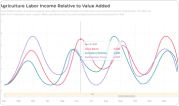- Economic
- Agriculture
- Construction
- Finance
- Labor
- Employment to Population Ratio
- Female Employment to Population Ratio
- Female Labor Force Participation
- Female Unemployment Rate
- Labor Force Participation Rate
- Male Employment to Population Ratio
- Male Labor Force Participation Rate
- Male Unemployment Rate
- Not in Education, Emoloyment, or Training
- Unemployment Rate
- Working Student
- Macroeconomics
- Manufacturing
- Mining
- Services
- Trade and Hospitality
- Transportation and Communication
- Utilities
- Environmental
- Social
- Semua Data
Interval
Kustom Waktu
Satuan
Interval
Kustom Waktu
Dari
Sampai
Satuan
Access to Electricity
Access to Electricity
NA
<
50
55
65
70
75
80
85
90
95
>
100
Access to Electricity
| Provinsi | Pct listrik |
|---|
Sumber Data
Access to Electricity
Sumber Data
:
The National Socioeconomic Survey Indonesia (SUSENAS), processed by LPEM FEB UI
Terakhir diperbaharui
:
31 Desember 2019
The figures reported in the tabulation indicate the weighted percentage of households in the area (district, province, or nation-wide) that possess access to electricity. We define those with access to electricity as being households who use electricity (PLN and non-PLN alike) as their main source of light. Data are taken from Susenas 1995-2019. Percentage figures are missing in 2005, as electricity access was not included in that year's survey instrument.
Unduh
Grafik


Access to Electricity
Satuan :
Interval : undefinedly -
NA
<
50
55
65
70
75
80
85
90
95
>
100
Access to Electricity
Satuan :
Interval : Tahunan


